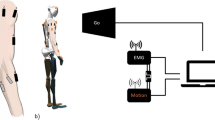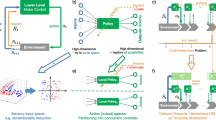Abstract
How does the brain adapt to slow changes in the body’s kinematic chain? And how can it perform complex operations that need tool use? Here, we consider both processes through the same perspective and propose that the kinematic chain is represented by an Active Inference model encoding, in a hierarchical fashion, intrinsic and extrinsic information separately. However, the several pathways through which prediction errors can be minimized introduce some optimization problems. We show that an agent can rapidly change its kinematic chain online using action-perception cycles, similar to how learning and inference processes are handled in Predictive Coding Networks.
Supported by European Union H2020-EIC-FETPROACT-2019 grant 951910 to IPS and Italian PRIN grant 2017KZNZLN to IPS.
Access this chapter
Tax calculation will be finalised at checkout
Purchases are for personal use only
Similar content being viewed by others
References
Adams, R.A., Shipp, S., Friston, K.J.: Predictions not commands: active inference in the motor system. Brain Struct. Funct. 218(3), 611–643 (2013). https://doi.org/10.1007/s00429-012-0475-5
Anil Meera, A., Novicky, F., Parr, T., Friston, K., Lanillos, P., Sajid, N.: Reclaiming saliency: rhythmic precision-modulated action and perception. Front. Neurorobot. 16, 1–23 (2022). https://doi.org/10.3389/fnbot.2022.896229
Çatal, O., Verbelen, T., Van de Maele, T., Dhoedt, B., Safron, A.: Robot navigation as hierarchical active inference. Neural Netw. 142, 192–204 (2021)
Dempster, A.P., Laird, N.M., Rubin, D.B.: Maximum likelihood from incomplete data via the EM algorithm. J. Roy. Stat. Soc. Ser. B (Methodol.) 39(1), 1–22 (1977)
Fiebelkorn, I.C., Kastner, S.: A rhythmic theory of attention. Trends Cogn. Sci. 23, 87–101 (2019). https://doi.org/10.1016/j.tics.2018.11.009
Friston, K.: What is optimal about motor control? Neuron 72(3), 488–498 (2011). https://doi.org/10.1016/j.neuron.2011.10.018
Friston, K.J., Daunizeau, J., Kilner, J., Kiebel, S.J.: Action and behavior: a free-energy formulation. Biol. Cybern. 102(3), 227–260 (2010). https://doi.org/10.1007/s00422-010-0364-z
Friston, K.J., Mattout, J., Kilner, J.: Action understanding and active inference. Biol. Cybern. 104(1–2), 137–60 (2011). https://doi.org/10.1007/s00422-011-0424-z
Friston, K.J., Rosch, R., Parr, T., Price, C., Bowman, H.: Deep temporal models and active inference. Neurosci. Biobehav. Rev. 77, 388–402 (2017). https://doi.org/10.1016/j.neubiorev.2017.04.009
Fuhr, P., et al.: Physiological analysis of motor reorganization following lower limb amputation. Electroencephalogr. Clin. Neurophysiol./Evoked Potentials 85(1), 53–60 (1992). https://doi.org/10.1016/0168-5597(92)90102-H
Hohwy, J.: The Predictive Mind. Oxford University Press, Oxford (2013)
Lanillos, P., Pages, J., Cheng, G.: Robot self/other distinction: active inference meets neural networks learning in a mirror (ECAI) (2020). https://arxiv.org/abs/2004.05473
Millidge, B., Osanlouy, M., Bogacz, R.: Predictive Coding Networks for Temporal Prediction, pp. 1–59 (2023)
Millidge, B., Tschantz, A., Buckley, C.L.: Predictive coding approximates backprop along arbitrary computation graphs. Neural Comput. 34(6), 1329–1368 (2022). https://doi.org/10.1162/neco_a_01497
Obayashi, S., et al.: Functional brain mapping of monkey tool use. Neuroimage 14(4), 853–861 (2001). https://doi.org/10.1006/nimg.2001.0878
Oliver, G., Lanillos, P., Cheng, G.: An empirical study of active inference on a humanoid robot. IEEE Trans. Cogn. Dev. Syst. 8920(c), 1–10 (2021). https://doi.org/10.1109/TCDS.2021.3049907
Parr, T., Pezzulo, G., Friston, K.J.: Active inference: the free energy principle in mind, brain, and behavior (2022)
Pezzulo, G., Rigoli, F., Friston, K.J.: Hierarchical active inference: a theory of motivated control. Trends Cogn. Sci. 22(4), 294–306 (2018)
Priorelli, M., Pezzulo, G., Stoianov, I.P.: Deep kinematic inference affords efficient and scalable control of bodily movements. bioRxiv (2023). https://doi.org/10.1101/2023.05.04.539409. https://www.biorxiv.org/content/early/2023/05/05/2023.05.04.539409
Priorelli, M., Stoianov, I.P.: Intention modulation for multi-step tasks in continuous time active inference. In: Active Inference, Third International Workshop, IWAI 2022, Grenoble, France, 19 September 2022 (2022). https://link.springer.com/book/9783031287206
Priorelli, M., Stoianov, I.P.: Flexible intentions: an active inference theory. Front. Comput. Neurosci. (2023). https://doi.org/10.3389/fncom.2023.1128694
Stengel, R.F.: Optimal control and estimation (1994)
Todorov, E.: Optimality principles in sensorimotor control. Nat. Neurosci. 7, 907–915 (2004). https://doi.org/10.1038/nn1309
Whittington, J.C., Bogacz, R.: Theories of error back-propagation in the brain. Trends Cogn. Sci. 23(3), 235–250 (2019)
Author information
Authors and Affiliations
Corresponding author
Editor information
Editors and Affiliations
Rights and permissions
Copyright information
© 2024 The Author(s), under exclusive license to Springer Nature Switzerland AG
About this paper
Cite this paper
Priorelli, M., Stoianov, I.P. (2024). Efficient Motor Learning Through Action-Perception Cycles in Deep Kinematic Inference. In: Buckley, C.L., et al. Active Inference. IWAI 2023. Communications in Computer and Information Science, vol 1915. Springer, Cham. https://doi.org/10.1007/978-3-031-47958-8_5
Download citation
DOI: https://doi.org/10.1007/978-3-031-47958-8_5
Published:
Publisher Name: Springer, Cham
Print ISBN: 978-3-031-47957-1
Online ISBN: 978-3-031-47958-8
eBook Packages: Computer ScienceComputer Science (R0)




